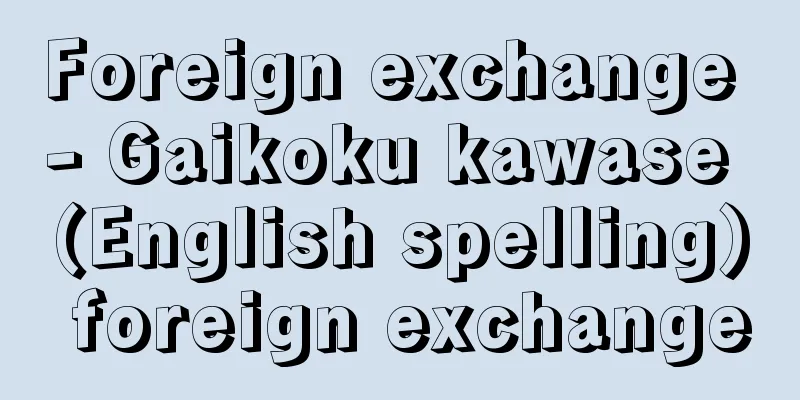Foreign exchange - Gaikoku kawase (English spelling) foreign exchange

|
The method of settlement between distant locations using a financial institution as an intermediary rather than by cash transfer is called foreign exchange, and foreign exchange is used when the other party is in a foreign country. [Tsuchiya Rokuro] How foreign exchange worksInternational payment methods can be broadly divided into two categories: sending funds (remittance money orders) and collecting funds (collection money orders). (1) Remittance Exchange Let's take the example of sending money from Tokyo to New York. The remitter goes to a foreign exchange bank in Tokyo, pays in yen and receives a foreign exchange bill (or check). This is then mailed to the recipient in New York, who presents it to a designated local exchange bank (either a branch or a correspondent that has a trading contract with the Tokyo exchange bank) and receives dollars. This completes the transfer between the parties, but the resulting interbank credits and payables are settled by book transfer along with other credits and payables. This method is called normal exchange, as the funds move in the same direction as the bill is mailed. When a transfer is urgent, a telegraphic transfer (TT), which is equivalent to domestic telegraphic transfer, is used. (2) Collection Exchange This method is mainly used for trade settlement. An exporter in Tokyo waits until the export goods have been shipped, then issues a bill of exchange (export bill) with an importer in New York as the payor and an exchange bank as the payee, and takes it to an exchange bank. The bank checks the shipping documents (bill of lading, insurance policy, waybill) that serve as collateral for the bill, and a letter of credit (L/C) from a foreign bank that guarantees the importer's payment, then purchases the bill and mails it together with the shipping documents to a branch or correspondent in New York. When the due date arrives, the branch or correspondent presents the bill to the importer and requests payment. The settlement of claims and debts between exchange banks is the same as for remittance exchanges. This method is called reverse exchange because the direction of the bill of exchange and the direction of the funds are opposite, but it is not used in domestic exchange. It is used only in foreign trade because the parties involved in settlement are far apart, and it takes too long for the importer to send the money to the exporter using the above-mentioned parallel exchange method after receiving the goods. With the reverse exchange method, the exporter can collect the payment by issuing the export bill at the same time as the goods are unloaded. However, for this method to operate smoothly, the export bill must be credible, and the above-mentioned shipping documents and letters of credit were developed to reinforce this. In order for the importer to receive the goods from the shipping company, he needs to obtain the shipping documents, which requires the payment of the bill to the exchange bank (in the case of a bill of exchange payable at sight) or the acceptance of the bill (in the case of a bill of exchange with a fixed term). If the importer cannot pay the payment, the bank can take the goods and resell them to minimize the loss. In this case, if a letter of credit has been issued, the payment of the payment is generally accepted by the bank that issued the letter of credit. [Tsuchiya Rokuro] Types of foreign exchange billsForeign bills of exchange are divided into various types depending on how they are classified. For example, they can be divided into remittance bills and export (import) bills according to the purpose of payment. The former are used for payments other than trade. The latter generally take the form of a document bill with shipping documents attached. They can also be divided into sight bills and fixed-term bills depending on the length of the payment period. The former are paid immediately when the bill is presented to the payor or the destination bank, and are common in remittances. In contrast, fixed-term bills, such as 30, 60, or 90 days after sight, are often used to settle import and export payments. This allows banks to defer payment to importers, and is a typical method of import financing (called import usance). When exchange rates fluctuate, it is important whether the bill amount is denominated in a foreign currency (called a foreign currency bill, and in Japan, dollar bills and pound bills are the most common) or Japanese yen bill (called a Japanese yen bill, and in Japan, yen bill). In the case of a Japanese yen bill, the exchange risk associated with fluctuations in exchange rates is borne by the other party, but in the case of a foreign currency bill, the risk is borne by the home country. Therefore, a Japanese yen bill is preferable to avoid exchange rate risk, but which one to choose when issuing a bill depends on the strength of your negotiating power with the other party. Depending on the international currency status of the country's currency and the competitiveness of the goods being traded, a Japanese yen bill can generally be chosen if it is advantageous in negotiations. [Tsuchiya Rokuro] Foreign Exchange MarketThe place where foreign exchange is bought and sold is called the foreign exchange market, where various foreign exchange transactions are carried out by exchange banks, traders, exchange brokers, and sometimes speculators and governments. At the center of this are exchange banks, which undertake overseas settlements at the request of their customers and also provide financing to traders. Today, the world's foreign exchange markets are in New York, London, Zurich, Frankfurt, and so on, but in Japan, Tokyo is the central market. Customer transactions are transactions in which exchange banks buy and sell foreign exchange with traders and other parties, but foreign exchange denominated in a foreign currency is exposed to exchange risk, so position adjustment transactions are conducted with other banks as a way to avoid this. Since exchange banks are settlement agents and trade financial institutions at the same time, they must constantly adjust their foreign currency funds and Japanese yen funds. This operation is also generally carried out in the form of foreign exchange sales and purchases with other banks. Arbitrage transactions are also conducted between banks. Exchange arbitrage is the process of taking advantage of regional imbalances in exchange rates to earn interest margins, while interest rate arbitrage is the process of taking advantage of interest rate differences between countries to earn interest margins. The above exchange transactions are conducted not only in spot (spot) exchange, but also in forward exchange. As described above, various types of foreign exchange transactions take place in the foreign exchange market, through which international settlements are made. In the first stage, credits and debts arise between traders and others, which are then shouldered by the exchange bank. In the second stage, banks try to offset credits and debts between themselves, but for this to happen smoothly for all banks, the external credits and debts that arose in the first stage must match, i.e., the balance of payments must be in balance. If the balance of payments is in deficit, there will be a shortage of foreign currency in the foreign exchange market, and the exchange rate of the foreign currency will rise. Conversely, if the balance of payments is in surplus, the exchange rate of the foreign currency will fall. Such fluctuations in exchange rates generally function to adjust the balance of payments, just as fluctuations in commodity prices generally function to balance supply and demand. However, excessive fluctuations in exchange rates have a negative impact on normal foreign transactions such as trade, and ultimately on the national economy, so monetary authorities may intervene in the market to suppress the fluctuations. [Tsuchiya Rokuro] "Knowledge of Foreign Exchange" by Masashi Tani and Seiichiro Oba (Nikkei Bunko)" ▽ "The Story of Foreign Exchange" by Tadashi Adachi (1982, Toyo Keizai Shinposha)" ▽ "Modern International Finance" edited by Morito Ando and Rokuro Tsuchiya (1984, Yuhikaku)" ▽ "Foreign Exchange Theory" by Shigeru Kimura, 4th edition (1997, Yuhikaku)" [Reference item] |©Shogakukan "> How remittance and collection money orders work ©Shogakukan "> Forex Trading Types Source: Shogakukan Encyclopedia Nipponica About Encyclopedia Nipponica Information | Legend |
|
隔地間の決済を現金の送金によらないで金融機関を仲介にして行う方法を為替といい、相手が外国にいる場合に用いられるのが外国為替である。 [土屋六郎] 外国為替の仕組み国際間の決済の方法には、大別すると資金を送金する方法(送金為替)と資金を取り立てる方法(取立為替)とがある。 (1)送金為替 東京からニューヨークへ送金する場合を例にとる。送金人は東京の外国為替銀行に出向いて、円を払い込んで外国為替手形(または小切手)を受け取る。これをニューヨークの受取人に郵送し、受取人はそれを指定された現地の為替銀行(支店または東京の為替銀行と取引契約を結んでいるコルレス先)に呈示してドルを受け取る。これで当事者間の送金は完了するが、その結果生じた銀行間の債権・債務は他の債権・債務とともに帳簿上の振替で清算される。この方法は資金が移動する方向と手形が郵送される方向が同じであるので並(なみ)為替という。送金を急ぐ場合には、国内の電報為替に相当する電信為替(TT)が用いられる。 (2)取立為替 主として貿易の決済に用いる方法である。東京の輸出商は輸出貨物の船積み完了を待ってニューヨークの輸入商を支払人、為替銀行を受取人とする為替手形(輸出手形)を振り出し、これを為替銀行に持ち込む。銀行は手形の担保となる船積書類(船荷証券、保険証券、送り状)や、輸入商の支払いを保証する外国銀行の信用状(L/C)などを確認したうえ、この手形を買い取り、船積書類とともにニューヨークの支店またはコルレス先へ郵送する。支店またはコルレス先では、期日がくれば輸入商に手形を呈示して代金の支払いを求める。為替銀行間の債権・債務の清算は送金為替の場合と同じである。 この方法は為替手形の郵送方向と資金の移動方向が逆であるので逆為替というが、内国為替ではみられない方法である。外国貿易に限って用いられるのは、決済の当事者が離れているので、輸入商が貨物を受け取ったあとに前述の並為替方式で輸出商へ送金するのでは時間がかかりすぎるからである。逆為替方式によれば、輸出商は貨物の積み出しと同時に輸出手形を振り出して代金を回収することができる。ただしこの方式がスムーズに運営されるためには輸出手形に信用がなければならず、それを補強するものとして発達したのが前述の船積書類や信用状であった。輸入商が貨物を船会社から受け取るためには船積書類を入手する必要があり、それには為替銀行に対し手形代金の支払い(一覧払手形の場合)か、手形の引受け(期限付手形の場合)をしなければならない。ここで輸入商が代金を支払えないときは、銀行が貨物を引き取り、転売することによって損失を最小限度に止めることができる。この際、信用状が発行されていれば、一般に代金の支払いは信用状発行銀行が引き受けることになる。 [土屋六郎] 外国為替手形の種類外国為替手形は、分類の仕方によっていろいろの種類に分かれる。たとえば、決済用途に従って送金為替手形と輸出(入)為替手形とに分かれる。前者は貿易以外の決済に用いられる。後者では船積書類が添付された荷為替手形の形式をとるのが一般である。また、支払い期限の長短によって一覧払手形(参着払手形)と期限付手形とに分かれる。前者は手形を支払人または名あての銀行に持参すればただちに支払ってくれるもので、送金為替に多い。これに対し輸出入代金の決済にはむしろ一覧後30日払い、60日払い、90日払いなどの期限付手形が多く利用される。これは銀行が輸入業者に対し支払いの繰延べを認めるもので、代表的な輸入金融の方法である(輸入ユーザンスという)。 為替相場が変動する場合には、手形金額が外貨表示(外貨手形といい、日本ではドル手形とポンド手形が多い)か邦貨表示(邦貨手形といい、日本では円手形)かが重要となる。邦貨手形の場合には、為替相場の変動に伴う為替リスクは相手側が負担するが、外貨表示の場合には自国側の負担となる。したがって為替リスクを回避するには邦貨手形が望ましいが、手形発行の際にいずれを選ぶかは相手との交渉力の強弱に左右される。その国の通貨の国際通貨性や取引される商品の競争力などにより、交渉上有利な場合には一般に邦貨表示手形を選択できる。 [土屋六郎] 外国為替市場外国為替が売買される場を外国為替市場といい、為替銀行、貿易業者、為替仲買人、ときには投機筋や政府も加わってさまざまな外国為替取引が行われる。中心となるのは為替銀行であって、顧客の求めに応じて対外決済を引き受けると同時に貿易業者に対して金融を行う。今日世界的な外国為替市場はニューヨーク、ロンドン、チューリヒ、フランクフルトなどであるが、日本では東京が中心的市場となっている。 対顧客取引は為替銀行が貿易業者などを相手に行う外国為替の売買であるが、外貨表示の外国為替については為替リスクにさらされるので、その回避策として他行との間で行う為替取引が持高調整取引である。為替銀行は決済の代行機関であると同時に貿易金融機関でもあるので、つねに外貨資金と邦貨資金を調整しておく必要がある。この操作もまた他行に対する為替売買の形で行われるのが一般である。銀行間ではさらに裁定取引も実施される。為替相場の地域的不均衡につけこんで利鞘(りざや)を稼ぐのが為替裁定、国際間の金利差を利用して利鞘を稼ぐのが金利裁定である。以上の諸為替取引は、現物(直物(じきもの))為替のほかに、先物(さきもの)為替でも行われる。 外国為替市場では以上のように各種の為替取引が行われるが、それを通じて国際間の決済がなされる。まず第1段階では貿易業者などの間で債権・債務が発生するが、それは為替銀行に肩代りされる。第2段階では銀行は相互間で債権・債務の相殺を図るが、これがすべての銀行でスムーズに行われるためには、第1段階で発生した対外的債権と債務が一致していること、すなわち国際収支が均衡していなければならない。もし国際収支が赤字であれば、為替市場では外貨が不足するので外貨の相場が上昇する。逆に国際収支が黒字の場合には、外貨の相場は下落する。このような為替相場の変動は、一般に商品価格の変動がその需要と供給を均衡させる働きをもつのと同様に、国際収支を調整する働きをもつ。しかしながら為替相場の変動があまり激しいのは、貿易など正常な対外取引、ひいては国民経済に悪い影響を与えるので、通貨当局が市場介入によって変動を抑えることがある。 [土屋六郎] 『谷柾・大場誠一郎著『外国為替の知識』(日経文庫)』▽『足立禎著『外国為替の話』(1982・東洋経済新報社)』▽『安東盛人・土屋六郎編『現代の国際金融』(1984・有斐閣)』▽『木村滋著『外国為替論』第4版(1997・有斐閣)』 [参照項目] |©Shogakukan"> 送金為替と取立為替の仕組み ©Shogakukan"> 外国為替取引の種類 出典 小学館 日本大百科全書(ニッポニカ)日本大百科全書(ニッポニカ)について 情報 | 凡例 |
<<: Foreign Exchange and Foreign Trade Law - Gaikokukawase to gaikokubouekiho
>>: Foreign company - gaikokukaisha (English spelling) foreign company
Recommend
Emperor Kasuganomiya
?-716 Asuka - A retired emperor of the Nara perio...
Aelianus, Tactius; Taktios Ailianos
A Greek military writer who lived in Rome in the 2...
Mr. Matsunaga
A samurai family from the end of the Warring State...
Sasaya Pass - Sasaya Pass
A pass on the border between Kawasaki Town, Shiba...
Okuetsu
...In the age of high-speed transportation, its i...
Kitasenba
...The name of the three Osaka districts in the E...
clavus
...The trimmings on Chanel suits and the bellows ...
Pascal's Principle - The Principle of Pascal
The principle that the pressure of each part of a...
Proboscidea (English spelling)
…He studied mainly mammal and reptile fossils, an...
Loxoblemmus aomoriensis (English spelling) Loxoblemmus aomoriensis
…[Yamazaki Harane]. … *Some of the terminology th...
Henry, Pierre
…He is the founder of musique concrète (concrete ...
Book of Songs
China's oldest poetry collection. It contains...
Social policy
...However, even within the Marxist anti-establis...
Blue-and-white flycatcher
It is a bird of the family Muscicapidae, subfamil...
Bacillus anthracis (English name)
…[Kazuo Komagata]. … *Some of the terminology tha...









